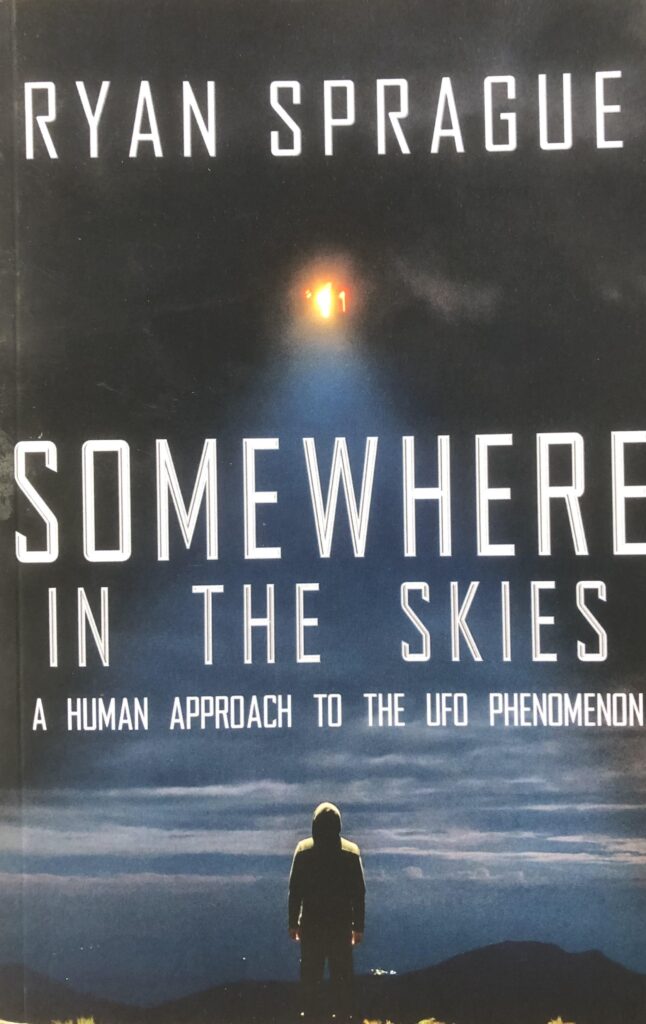
Somewhere In The Skies: A Human Approach To The UFO Phenomenon by Ryan Sprague. Beyond The Fray Publishing, San Diego, 2020. ISBN: 13: 978-1-7344198-7-0. 262 pp.
As we reach the 75th anniversary of the coining of the term ‘flying saucer’ it seems appropriate to look back at the history of a phenomenon which has since become known by the acronym ‘UFO’ and, more latterly, ‘UAP.’ For those wanting to embark on such a retrospective, Ryan Sprague’s fine book would be an excellent place to start.
One thing that comes through very clearly from his person-centred approach to UFO experiences is the sheer diversity of what experiencers report. Back in 1947 it was a somewhat distant observation of nine bright objects moving south from Mount Baker to Mount Rainier made by private pilot and fire-extinguisher salesman Kenneth Arnold. Flying geese-like in a diagonal ‘chain’ – ‘as if they were linked together’, as Arnold would comment later – his sighting of these flipping and flapping objects just before three o’clock in the afternoon on June 24th 1947 ushered in the current era of all things UFO. Fast forward three-quarters of a century, and the diversity – not to mention complexity – of what experiencers have reported in the intervening years is revealed as truly breath-taking. Sprague explores a wide range of such reports in ‘Somewhere In The Skies’, beginning with relatively straightforward sightings of flying orbs, triangles and lights before moving on to consider several very odd accounts of abductions and finishing with an overview of the flying ‘tic tac’ and other objects reported by Naval personnel during a 2004 military exercise aboard the USS Nimitz. None of this would be terribly original – there are many detailed and relatively up-to-date overviews of the UFO’s burgeoning history – save for the fact that the author explores a particular perspective in detail and throughout: that of the effect of their experiences on the experiencers.
Hence the subtitle of the book. In taking such a ‘human approach’, it is perhaps fitting that subjects’ reactions to their experiences turn out to be almost as diverse as the experiences themselves. Sometimes witnesses appear oddly indifferent to the most remarkable sightings, such as when a massive black chevron-shaped object hovering over a drive-in movie theatre produces an oddly muted response. By contrast, in the very next chapter, Sprague reports an experience which reduced two witnesses to tears. ‘For both,’ he states, ‘it was a moment of pure vulnerability.’
Diverse reactions to their experiences are equally apparent when the author turns to the odd events undergone by so-called ’abductees’, a subject which takes up much of the second part of the book. Some feel terror at realising they’ve been taken somewhere by ‘the aliens’ and cannot move. Yet for others the experience is positive; transformative, even. Indeed, reading this part of Sprague’s study I was struck by how many experiencers described their experiences using the language of spiritual awakening, such as ‘Bret’ who revealed to Sprague during an interview that whilst no longer religious, ‘I am a deeply spiritual person. I have a deep love and regard for our planet and especially the creatures that inhabit it. This was all set in motion by my experiences.’ Having a long-standing interest in Near-Death Experiences (NDEs), I’m struck as I re-read that sentence by how similar it is to the declarations of so many Near-Death Experiencers that their NDEs, whilst making them less religious, made them more spiritual. NDE researcher Kenneth Ring has historically drawn attention to just such UFO/NDE parallels but it remains an area ripe for further exploration.
Seventy-five years on from Kenneth Arnold’s epoch-ushering encounter near Washington’s Mount Rainier, we are still left with more questions than answers. It is to Ryan Sprague’s credit that he sees a human being behind every UFO testimony, recognising as he does that these vivid and diverse stories are, above all, human ones. Whatever the ‘facts’ behind these strange UFO events are, they are in a crucial sense human facts: narrated from particular points of view, by particular persons, at particular times and places. Sprague’s well-written, moving and meticulously-researched study lets the witnesses step out from behind their testimonies to speak of themselves: of their feelings, thoughts and lives both during and after their encounters. I commend it to anybody wondering what all the UFO ‘fuss’ is about and curious to find out more.
This review first appeared in Fellowship Review, No. 255, Summer 2022, pp. 35 – 7